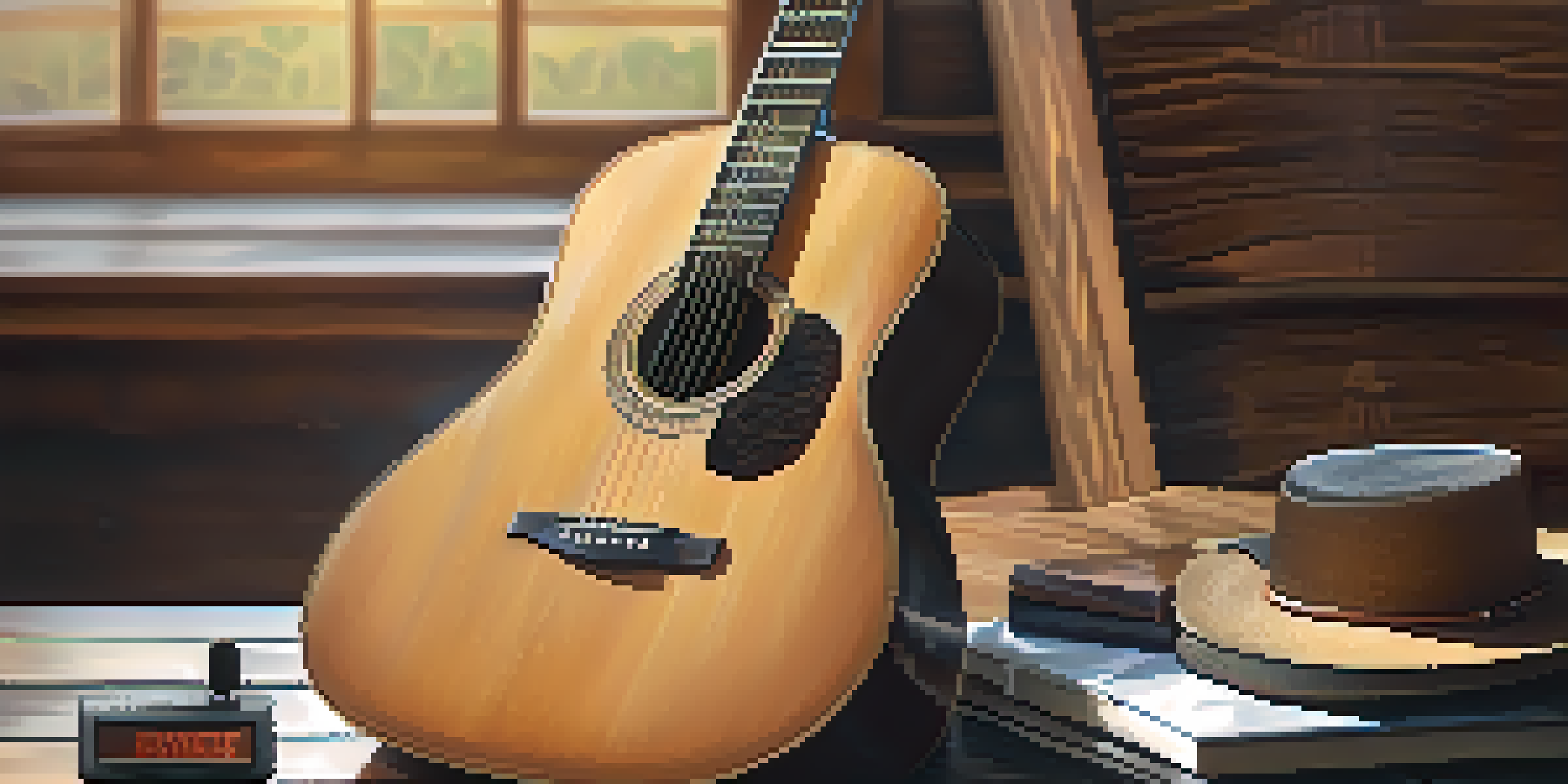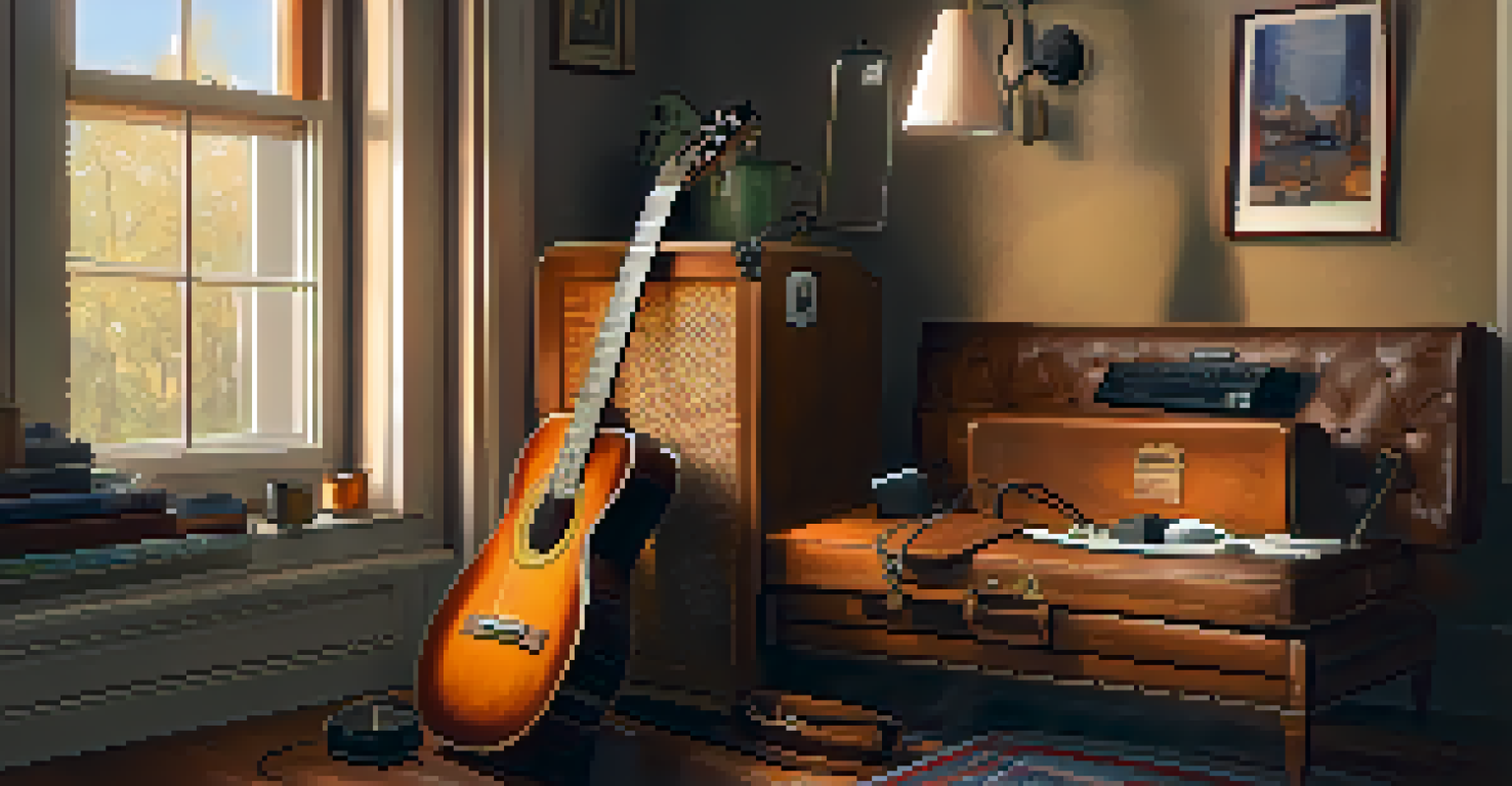Exploring Guitar Humidifiers: Keeping Your Instrument Safe

Understanding the Importance of Humidity for Guitars
Humidity plays a crucial role in maintaining the integrity of your guitar. Instruments, especially wooden ones, are sensitive to environmental changes. Too much moisture can cause warping, while too little can lead to cracks and other damage.
The guitar is a small orchestra. It is a great treasure that I hold in my hands.
Think of your guitar like a delicate plant; it thrives in the right conditions. When humidity levels fluctuate, your guitar can suffer, impacting its sound and playability. This is why understanding the importance of humidity is key for every guitarist.
Keeping your guitar in a stable environment is essential. This is where guitar humidifiers come into play, acting like a safety net that helps maintain the ideal humidity level to protect your beloved instrument.
What Is a Guitar Humidifier and How Does It Work?
A guitar humidifier is a device designed to maintain moisture levels within your instrument's case or environment. It typically contains a sponge or gel that releases water vapor gradually, helping to keep humidity consistent. This ensures that your guitar remains in optimal condition.

To visualize it, think of a humidifier as a mini spa for your guitar, providing the right balance of moisture just like a spa provides relaxation for you. By releasing moisture, it prevents the wood from drying out and cracking, allowing for better sound quality and longevity.
Humidity is crucial for guitars
Maintaining the right humidity levels prevents warping and cracks in wooden guitars, ensuring optimal sound and playability.
There are different types of guitar humidifiers available, such as soundhole humidifiers and case humidifiers. Each type has its unique benefits, so choosing one that best suits your needs is crucial for effective maintenance.
Types of Guitar Humidifiers: Which One to Choose?
When it comes to guitar humidifiers, there are primarily two types: soundhole and case humidifiers. Soundhole humidifiers sit directly inside the guitar, while case humidifiers are placed inside the case. Both serve the same purpose but offer different methods of maintaining humidity.
Just as a plant needs water to thrive, so does a guitar need the right humidity to maintain its sound and structure.
Soundhole humidifiers, like the name suggests, fit snugly in the soundhole of your guitar. They are often easier to use and monitor, providing direct moisture to the instrument. On the other hand, case humidifiers are great for those who want to maintain humidity for multiple guitars simultaneously.
Choosing the right humidifier depends on your specific needs and the environment where you store your guitar. If you live in a particularly dry area or have a collection, investing in both types could be beneficial.
How to Properly Use a Guitar Humidifier
Using a guitar humidifier effectively requires a bit of understanding and care. First, make sure to fill your humidifier with distilled water, as tap water can introduce minerals that may harm your instrument. Once filled, place it in the appropriate location, whether it's in the soundhole or inside the case.
It's crucial to monitor the humidity levels regularly. Many guitarists find that a digital hygrometer, which measures humidity, is a useful companion to their humidifier. This way, you can ensure that the environment remains within the ideal range of 45% to 55% humidity.
Guitar humidifiers protect instruments
Using a guitar humidifier helps maintain consistent moisture levels, acting as a spa for your instrument to enhance its longevity.
Also, remember to check and refill your humidifier regularly. Depending on the climate and your guitar's needs, you may need to adjust how often you do this. Keeping a consistent routine will help your guitar stay healthy and sound its best.
Signs Your Guitar Needs Humidification
Recognizing the signs that your guitar needs humidification is essential for its care. Common indicators include visible cracks in the wood, sharp fret edges, or a significant change in sound quality. If you notice any of these issues, it’s time to take action.
Another sign to watch for is the guitar's body becoming overly dry to the touch. Just like your skin can feel dry in low humidity, your guitar can show similar signs. Paying attention to these physical changes can help you prevent more severe damage.
If you find yourself frequently adjusting your guitar's setup to maintain playability, this could indicate that the humidity levels are off. Regular use of a humidifier can help stabilize your instrument, allowing you to focus on playing instead of constant adjustments.
Maintaining the Right Humidity Level for Your Guitar
Maintaining the right humidity level for your guitar is a balancing act. Ideally, you want to keep the humidity between 45% and 55%. This range helps to prevent the wood from drying out or absorbing too much moisture.
Using a hygrometer can help you keep track of the humidity levels in your guitar case or environment. If you notice levels falling below 45%, it’s time to act and add moisture to the air. Conversely, if levels rise above 55%, you may need to lessen the amount of moisture you’re adding.
Monitor humidity for best care
Regularly checking humidity levels with a hygrometer ensures your guitar stays in the ideal range, preventing damage and maintaining its quality.
Creating a stable environment for your guitar is just as important as using a humidifier. Avoid placing your instrument near heat sources or air conditioning vents, as these can create drastic fluctuations in humidity. A consistent environment paired with a humidifier will keep your guitar sounding great.
The Long-Term Benefits of Using a Guitar Humidifier
Using a guitar humidifier isn’t just about immediate protection; it’s also a long-term investment in your instrument's health. By maintaining optimal humidity levels, you can significantly extend the lifespan of your guitar. This means fewer repairs and a better playing experience over time.
Think of it as a preventive measure—just like regular check-ups at the doctor keep you healthy. A well-cared-for guitar will not only sound better but also maintain its aesthetic appeal. Avoiding cracks and warping helps preserve its value, which is especially important for vintage or high-end models.

Ultimately, the long-term benefits of using a guitar humidifier far outweigh the small effort it takes to incorporate one into your routine. Your guitar deserves the best care, and a humidifier is a simple yet effective way to provide it.